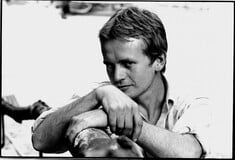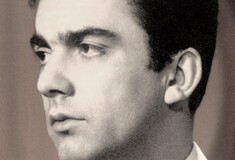
Βλ. dorotheum.

Αριστ. : "Zen for Walking", Exposition of Music, Electronic Television, Galerie Parnass, Wuppertal, 1963. Φωτ. Manfred Montwé.

O Nam June Paik με τους φίλους του καλλιτέχνες Gregory Battcock και HA Schult. New York, 1981. Βλ. haschult.de.

The More the Better, (1988) Three channel video installation with 1,003 monitors and steel structure; color, sound; approx. 60 ft. high. Βλ. Nam June Paik official website.

Δύο πρώιμα έργα του Nam June Paik. Βλ. Jussi Parikka - Cartographies of Media Archaeology.

Βλ. The Portfolio of Eric Reber.

Performance Zen for Head (1962). Βλ. studyblue.

O Nam June Paik με τη γυναίκα του, την επίσης καλλιτέχνιδα Shigeko Kubota, στο στουντιό τους στη Νέα Υόρκη (1974). Βλ. Woongjin ThinkBig, publisher of "My Love, Nam June Paik".

Shigeko Kubota, Vagina Painting (1965). Βλ. studyblue.

Robot K-456. 'Ενα έργο που δημιουργήθηκε από τη συνεργασία του Nam June Paik με τον Ιάπωνα Shuya Abe. Βλ. cyberneticzoo.com (a history of cybernetic animals and early robots).

Robot K-456. "The First Catastrophe of the 21st Century". Τηλεκατευθυνόμενος περίπατος στο Manhattan, έξω από το Whitney Museum (1982). Πάνω στη διάβαση της Madison Avenue, το ρομπότ συγκρούστηκε "τυχαία" με αυτοκίνητο που οδηγούσε ο καλλιτέχνης Bill Anastasi (από τους κύριους δημιουργούς της εννοιολογικής και μίνιμαλ τέχνης). Φωτ. George Hirose και John G. Hanhardt. Βλ. cyberneticzoo.

Ο Nam June Paik στο στουντιό του με την Charlotte Moorman και το K-456 (1964). Τις φωτογραφίες τράβηξε ο Peter Moore πριν την πρώτη κοινή τους εμφάνιση στο Β' ετήσιο New York Avant-Garde Festival (Αύγουστος 1964). Βλ. cyberneticzoo.

Σ' αυτό το πολαρόιντ, ο Nam June Paik και η Shirley Clarke προσπαθούν να φιληθούν στα πλαίσια μιας εγκατάστασης που δημιούργησε ο David Cort (the Kitchen, 1974). Βλ. Pleasure Palace Theater of the Future.

Αριστ., TV Cello. Δεξιά, TV Bra. Στη μικρή φωτογραφία, περφόρμανς στη Γερμανία (1965). Πάνω, η Charlotte Moorman με τους Jerome Wiesner, Otto Piene και Nam June Paik.


Αριστ. με τον John Cage στο τέλος μιας περφόρμανς. Via uncertaintimes. Βλ. το αφιέρωμα στον John Cage (Σαν Σήμερα, 29.8.2012).


Ακούγοντας τη μουσική με το στόμα. Listening to Music through the Mouth, Nam June Paik και Wolf Vostell. Βλ. jurnalsegiempat.

Η Charlotte Moorman στην περφόρμανς TV Bra του Nam June Paik. Βλ. merida75.

Nam June Paik, TV Cello Premiere (1971).

TV Cello (Concerto for TV).

Βλ. Michigan State University.

One For Violin (1962). Περφόρμανς του Nam June Paik στο Düsseldorf στα πλαίσια της εκδήλωσης Neo-Dada in der Musik του κινήματος Fluxus. Τις φωτογραφίες τράβηξε ο λιθουανός καλλιτέχνης -και κεντρικός συντονιστής του Fluxus- George Maciunas. Στο κίνημα Fluxus μετείχαν, εκτός από τους George Maciunas και Nam June Paik, οι Ay-O, Joseph Beuys, George Brecht, Dick Higgins, Yoko Ono, και Wolf Vostell. Βλ. Thesis Notes and Headaches.

Στην επέτειο των 50 χρόνων από την πρώτη περφόρμανς One For Violin του Nam June Paik, ο αμερικανός ποιητής και καλλιτέχνης C. Mehrl Bennett έσπασε ένα βιολί πάνω σε ένα ξύλινο τραπέζι στο σπίτι του στο Columbus (Ohio, USA). Βλ. Over the Sofa/Under the Skin/Inside the Head.

Αριστ., ο Nam June Paik με τους Yoko Ono και John Lennon στην εκτέλεση του TV Cello στην Tate Liverpool (2003). Δεξ., ο γερμανός καλλιτέχνης Joseph Beuys σε μία κοινή συναυλία-περφόρμανς με τον Nam June Paik το 1981. Βλ. EAsyview.

Magnet TV, 1965.

Electronic Superhighway, 1995. Βλ. artshumanities.

Family of robots.

Δεξ., Hamlet Robot, 1996 (βίντεο-εγκατάσταση).

Βλ. Keep calm. Carry on.

Reclining Buddha, 1994 (2 color televisions, 2 Pioneer laser disk players, 2 original Paik laser disks, found object Buddha), James Cohan Gallery, New York. Βλ. art pulse.
 TV-Buddha, 1974.
TV-Buddha, 1974.

TV-Buddha.

Ommah ("μητέρα" στα κορεάτικα), 2005 (one channel video installation on 19-inch LCD monitor with silk robe, dimensions variable). Γι' αυτό το τελευταίο βιντεο-γλυπτό του Nam June Paik χρησιμοποιήθηκε ένα αγορίστικο ρούχο 100 ετών σε σχήμα σταυρού. Πάνω του προβάλλονταν εικόνες από παιχνίδια κοριτσιών της Κορέας και της Αμερικής, με έναν τρόπο που συνέδεε το παρελθόν με το παρόν. Permanent Collection of the National Gallery of Art, Washington, D.C. Βλ. thinkvisual.

Olympe de Gouge, έργο του Nam June Païk, αφιερωμένο στη γαλλίδα επαναστάτρια και φεμινίστρια του 18ου αι. Olympe de Gouge (αποκεφαλίστηκε το 1793 κατά την περίοδο της Τρομοκρατίας). Τοποθετήθηκε στην ειδική αίθουσα του Musée d'art moderne de la ville de Paris όπου εκτίθεται το έργο la Fée Electricité του γάλλου ζωγράφου Raoul Dufy.

"...Και χαίρομαι που τα κατάφερα, γιατί όλος ο κόσμος πίστευε πως ήμουν τρελός".


TV Rodin (Le penseur), 1976-78. Berlin Festival Transmediale. Φωτ. Jonathan Gröger.

TV Rodin (1982 version). Bronze sculpture with Sony Watchman television. James Cohan Gallery.Βλ. prosthetic knowledge.
T.V. Bra, Nam June Paik, Charlotte Moorman (1975).
Συνέντευξη της Shigeko Kubota, γυναίκας του Nam June Paik στην κορεάτικη εφημερίδα Κorea JoongAng Daily. By Moon So-young.
Q. You must feel special about this exhibition that starts on Paik's 80th birthday. What do you feel?
A. Too bad he's not here physically with us to enjoy this event. But his spirit is always with us.
I made his monument [she shows a photo of a sculpture depicting Paik with a violin in one hand and Buddha head in the other with TV monitors in his torso] ... It is now at my home [the apartment in New York where she spent more than three decades with Paik]. His spirit comes to the monument all the time and tells me I'm lazy and that I should work. I can't work as much as he did. He was a really hard worker.
And his spirit is not only with me but also with all of us. You know, life is short and art is long. That's true. Nam June's concept and art will survive for a long time. He developed the new art related to information, communication and cultural exchanges, which are a global topic now. He influenced the people of the next generation not only in art but also in lifestyle.
You and Paik participated in the Fluxus movement, which demolished borders between art genres and even between art and non-art. It seems that is the reality these days. What do you think?
Truly. Now the art image is life and the life image is art, and certainly, now, everyone can become an artist. That's good.
And this demolition of borders also includes borders between nations.
But sometimes I suspect that the world has turned more conservative than in the 1960s and 70s, which were the hippie times, dreaming of the borderless world and utopia.
I knew Paik only as a video artist, so I was impressed by "Robot K-456", which he developed with a Japanese engineer in 1964. Why didn't he continue to develop robots?
He didn't make the same thing all the time. He didn't like a series because he got tired it and then started on a new project. His brain was always working faster than his hands.
Paik is well-known for his use of cathode-ray tube TV monitors. He also used flat-screen TVs in his later years?
Such TV came just before he died, so he seldom used it.
Nam June was active in the period of boxy analog TVs. So he would make video sculptures with them, making the best use of their volume. Also, he would open the back part of TVs and change them to create works of art. It would be impossible to do that with flat-screen TVs.
I think he was born at the right time, not too early, not too late.
You are also an important artist. You said in your book that Paik was even jealous of your works inspired by French artist Marcel Duchamp. Were you ever jealous of him?
Oh, I was always jealous of Nam June. First of all, he invented video art.
And people surrounding us kept asking me, "Oh you're an artist, too?" And I answered, "Of course I AM."
It was not easy to live as the wife of a great artist and be an artist myself. I had to use whatever materials Nam June did not use. And, while Nam June's works were spectacular, my works tend to be personal and delicate - so they could be easily overshadowed by his works. Still, I have worked hard to be an original and good artist.
At the same time, I supported him. Nam June was really a hard worker, so I couldn't help him. In addition, he was alone. His family was in Korea. He had friends, but you know a friend is just a friend.
I heard you admire Duchamp. So if Duchamp had been your age, whom would you have chosen as your lover: him or Paik?
Oh, I heard Duchamp liked only rich women ... On the other hand, Nam June didn't like rich women and was never interested in being rich himself. He would say that if he had lots of money, he wouldn't be an artist. So he insisted on remaining the most starving artist in New York.
I think he was so indifferent to money because he had already seen so much of it when he was young.
Βλ. HanCinema, The Korean Movie and Drama Database.





























σχόλια